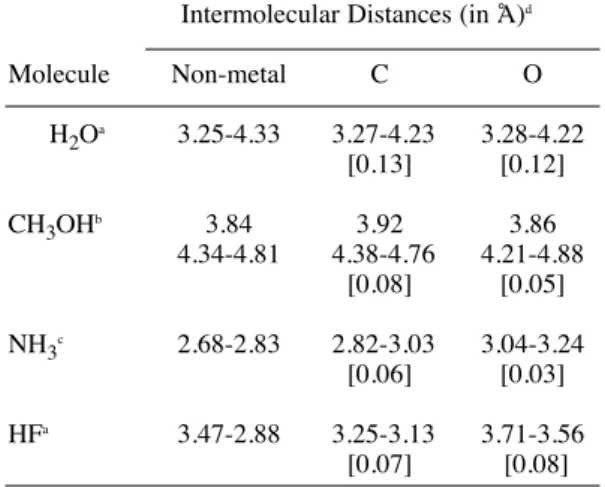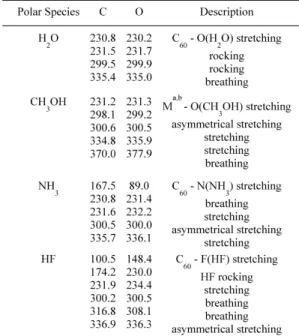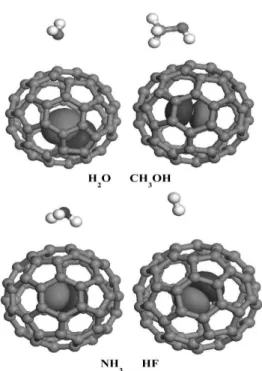Introduction
There have many several efforts in the use and evaluation of the physical properties of nano-materials. These investigations include the elucida-tion of the reactivity and structural capacities of the [60] fullerene (C60) species [1-10]. Such experi-ments are of use in surface chemistry as they per-mit the solvation properties to be modified [11]. An example of this phenomena is on the La@C60 sys-tem which has been shown to have metal-like con-ductive properties above 29 K [12].
This work is significant from the viewpoint of the theoretical design of new fullerene species that can be implemented as transport vesicles [13]. Our primary motivation is the amelioration of the chemical nature of these structures to improve polar molecule interactions [14-16]. Such intermol-ecular forces reduce the hydrophobic and toxic nature of the nanostructure. The dispersion of charge in guest materials can cause the guest mate-rial to be insensitive to the applied electrical field.
Other recent efforts in our group have demonstrated that the encapsulation of metals inside of fullerenes improves external interactions with small polar molecules [17-18]. In these efforts first
and second group metals were used to improve the interactions of the fullerenes to external polar species. Oxygen was employed in the study report-ed herein to analyze the affect that it has on the charge structure of the fullerene. From previous ref-erences [19] it has been shown that oxygen in the triplet state interacts well with the fullerenes leading to modifications of their external molecule solvation properties. To this end we have considered carbon and oxygen insertion (that both exist as triplets) in C60. It is our assertion that this charge transfer prop-erty can permit the fullerenes to form increased interactions with external polar molecules.
Computational methods
Density functional theory (DFT) calcula-tions have been done with the DMol3[20] numer-ical-based computer software implemented in the Materials Studio Modeling 3.1 package from Accelrys, Inc. Optimizations of the structural parameters and frequency calculations were per-formed with the BLYP general-gradient potential approximation in conjunction with the double-numerical plus diffusion basis set (all-electron
19 Ecl. Quím., São Paulo, 33(3): 19-22, 2008
www.scielo.br/eq www.ecletica.iq.unesp.br Volume 33, número 3, 2008
Effect of triplet encapsulated atoms in [60] fullerenes:
a theoretical analysis
A. F. Jalbout*
Instituto de Química, Universidad Nacional Autónoma de México, Circuito Exterior, Ciudad Universitaria 04510, México D.F., México
*ajalbout@u.arizona.edu
Abstract: The present investigation reports on the interaction of the C/O triplet atoms inside of the [60] fullerene (C60) species with small polar molecules (H2O, CH3OH, HF, NH3) using Density Functional Theory (DFT) calculations. The calculations show that in all the computed cases the enca-puslated complexes with the molecules are more stable than without internal atoms.
Table 1. The intermolecular distances (in Å) between the polar molecules and carbon atoms complexes.
Intermolecular Distances (in Å)d
Molecule Non-metal C O
H2Oa 3.25-4.33 3.27-4.23 3.28-4.22 [0.13] [0.12]
CH3OHb 3.84 3.92 3.86
4.34-4.81 4.38-4.76 4.21-4.88 [0.08] [0.05] NH3c 2.68-2.83 2.82-3.03 3.04-3.24
[0.06] [0.03] HFa 3.47-2.88 3.25-3.13 3.71-3.56
[0.07] [0.08] core treatment) was employed (denoted as
DND). The adsorption energies (∆E) for the com-plexes are defined as:
∆E= E
C/O@C60-polar species– ( EC/O@C60+ Epolar species).
The small polar molecules that were used are H2O, CH3OH, NH3and HF that have adequate affinities to the fullerene surface upon charge trans-fer. The adsorption energies are a measure of the strength of the interaction with the external polar molecules. Additionally, the vibrational frequen-cies have been studied to verify if the structures were local minimum structures.
Results and discussion
From previous discussions the encapsulat-ed atoms inside of the fullerene species are carbon and oxygen that both tend to exist in the triplet state naturally. The purpose of this study is to investigate the three body interactions with the fullerene and the external polar species. Several positions of the polar molecule and the endohedral atoms were performed in order to ensure that the minimum was indeed the lowest energy structure along the potential energy surface.
We will start the discussion by a description of the geometrical properties of the complexes studied. Scheme 1 shows the general interaction sites of the fullerene surface with values depicted in Table 1. The optimized BLYP/DND CC bond lengths for the fullerene are 1.40/1.46 Å that are in close experimental agreement. Also, the off-center displacements of the C/O atoms in the C60species is 0.0 Å, meaning that the atoms prefer to maintain a position at the center of the system.
20 Ecl. Quím., São Paulo, 33(3): 19-22, 2008
Scheme 1. Representation of the geometrical parameters used in Table 1.
aThe coordination of the hydrogen atom with the C1/C2
atoms without atoms, and coordination between the oxy-gen atom (or fluorine) and C2/C3 atoms with C/O.
bTwo interactions which are established as: 1) between
the H atom and C4 atom, and 2) for the O distance with the C3/C4 atoms.
cCoordination of a hydrogen atom with the C2/C3 atoms. dRelative distortions from the center of the fullerene (in the
C/O@C60we cases we computed a distortion of 0.0 Å).
From the first table we can see that for the H2O and HF cases it is clear that the hydrogen atom coordinates with C1/C2 without C/O present and the oxygen atom (or fluorine) with C2/C3 in the encapsulated complexes. In the case of CH3OH one can observe two primary interactions which are with the hydrogen atoms and C4 and for oxy-gen we obtain one interaction with C3/C4. Finally, in the case of ammonia (NH3) there is an interac-tion between the C2/C3 atoms and hydrogen.
In the absence of the endohedral species, the interaction of water happens at a an intermolecular separation of 3.25 and 4.33 Å for the distance of the hydrogen to C1 and C2, respectively. This atom will coordinate to the junction of the six-membered and five-membered rings. In the case of C this distance is now 3.27-4.23 Å and of oxygen it is 3.28-4.22 Å. The off-center displacement in the C and O cases with water is 0.13 Å and 0.12 Å, respectively.
sulated cases, respectively. The interactions appear to be slightly shorter in the case of O in the fullerene cage as a result of favorable three body chalcogenide interactions.
For NH
3we can observe that for the non-metal case, the closest interaction occurs with one of the hydrogen atoms and C2/C3. The intermole-cular interaction in the case of the isolated C60 -NH3 complex is 2.68 and 2.83 Å, respectively. Further encapsulation by C causes this distance to rise to 2.82 and 3.03 Å, and for O it is 3.04 and 3.24 Å. The off-center displacements of the C and O atoms is 0.06 and 0.03 Å, respectively. HF sol-vation provides a C1/C2 coordination of about 3.47/2.88 Å in the isolated case. Placement of the internal C atom causes this value to rise to 3.25/3.13 Å and with oxygen it is 3.71/3.56 Å. The off-center displacements are similar to those in methanol and are in the order of 0.07 and 0.08 Å, for C and O, respectively. The theoretical compu-tations show interesting chemical properties due to the coordination of the polar molecules to the six-five membered ring junction. This also arises from the fact that the five membered rings do not delo-calize excess charge well and can be used to enhance this property with the small polar species.
In Table 2 we present vibrational modes for the species studied. In the table we can observe that in the H2O case the frequencies for both are quite similar with the coupling to the oxygen atom being equivalent to the rocking modes of the fullerene-polar molecule system. In the next case (CH3OH) the coupling to the oxygen atom is attributed to the fullerene species with the breathing modes being increases. If we change the interaction to the NH3 case, the C species exhibits a larger tendency to interact with the nitrogen atom as is apparent from the frequencies. Finally, for HF we can see that when oxygen is inserted inside of the fullerene cage the rocking modes with the fullerene tend to increase. These low-frequency vibrational modes can be used to characterize differences in the vibra-tional spectra of the systems under consideration.
In this next step we will discuss the physical properties of the molecules studied in this work. The dissociation energies (∆E) isolated case has a
∆E value of -0.14 kcal/mol with the H2O molecule. Upon insertion with C and O this value is more favorable yielding quantities of -1.59 and -1.21 kcal/mol, respectively. The C, O atoms are known to be excellent quenchers of excited states [21] that can lead to the results obtained. The triplet states
21 Ecl. Quím., São Paulo, 33(3): 19-22, 2008
Table 2. Vibrational modes and their corresponding frequencies (in cm-1).
aM corresponds to the endohedral atoms.
b This mode can be used to quantify the strength of the
interactions with CH3OH.
tend to interact with the external polar molecule slightly improving their capacity to solvate.
For the CH3OH case the absorption ener-gies in both case is reduced however the O case is slightly larger. This molecular species is less polar and perhaps causes steric hindrance by the extra methyl group on this molecular species. For NH3 complexes again we see larger absorption energies after insertion of the C and O species with the O stabilization being larger. Finally, for HF the stabi-lization energies increase dramatically which can be caused by a favorable coupling between the C and O atoms as is apparent by the vibrational modes in Table 2.
Figure 1 graphically represents the HOMO molecular orbital density of the species studied. We Table 3. Adsorption energies (∆E) in kcal mol-1.
System C60 C@ C60 O@ C60
H2O -0.140 -1.594 -1.211
CH3OH -0.576 -0.585 -1.091
NH3 -1.040 -1.214 -1.521
HF -0.603 -4.396 -2.200
observe that in all cases the endohedral atom local-izes the majority of the electronic density therefore only yielding slight stabilization of the external polar species. In other cases [17] we have shown that Li, K and Na are excellent donors of electron-ic density and appear to show orbital mixing between the fullerene and the external polar species. In this case this localization leads to mini-mal charge transfer however, there is some degree of interaction between the C, O atoms and the external interacting polar molecule.
Conclusions
This work presents the results of theoreti-cal DFT theoreti-calculations of C/O@C60 interactions with small polar molecules (H2O, CH3OH, NH3 and HF). We have adequately demonstrated that the endohedral atoms improve the affinity of the fullerenes to the external polar species. It is our assertion that the endohedral atoms can serve towards effectively improving tertiary solvent interactions. The method discussed should permit one to quantify electron-polar molecule coupling interactions on fullerene surfaces that are caused by charge-transfer mechanisms.
22 Ecl. Quím., São Paulo, 33(3): 19-22, 2008
Figure 1. HOMO isosurfaces (at a 0.04 a.u. contour level) for interactions of the endohedral systems with the small polar molecules.
The carbon and oxygen atoms have the innate ability to transfer charge to a minor extent to the fullerenes that improves its affinity to external polar species. Since these are common components which are reactive it is our belief that the encapsu-lation process can be performed with ease. Interestingly, we found that the C and O atoms interact strongly with the HF polar species as is evi-dent from the table. The calculations shown should be of interest and of use to workers in the field.
Acknowledgments
We appreciate the financial and computatio-nal resources offered by DGSCA and the UNAM.
Received 28 April 2008 Accepted 07 July 2008
References
[1] H.W. Kroto, Nature, 318 (1985), p. 162.
[2] R. Klingeler G. Kann I. Wirth, J. Chem. Phys., 115 (2001), p. 7215.
[3] Y. H. Hu, E. Ruckenstein, J. Am. Chem. Soc., 32 (2005), p. 11277.
[4] A.F. Jalbout, F. Nazari, L. Turker, J. Mol. Struct. (THEOCHEM),627 (2004), p. 1.
[5] I.T. Belash, A.D. Bronnikov, O.V. Zharikov, A.V. Palnichenko Synth. Met. 36 (1990), p. 283.
[6] S. Guha, K. Nakamoto, Coord Chem Rev249 (2005), p. 1111. [7] L. Turker, S. Gumus, Poly. Arom. Comp. 26 (2006), p. 145. [8] H. Jantoljak, N. Krawez, I. Loa, R. Tellgmann, E.E. B. Campbell, A.P. Litvinchuk, C. Thomsen C., Z. Phys. Chem. (Munchen) 200 (1997), p. 157.
[9] V.K. Koltover, J. Mol. Liq.127 (2006), p. 139. [10].A. Gromov, N. Krawez, A. Lassesson, D.I. Ostrovskii, E.E.B. Campbell, Cur. App. Phys. 2 (2002), p. 51. [11] M. Pavanello, A.F. Jalbout, B. Trzaskowski, L. Adamowicz, Chem. Phys. Letts., 442 (2007), p. 339. [12] R. Klingeler, G. Kann and I. Wirth, J. Chem. Phys. 115 (2001), p. 7215.
[13] B. Trzaskowski, A.F. Jalbout and L. Adamowicz, Chem. Phys. Lett.430 (2006), p. 97.
[14] A.F. Jalbout, Chin. J. Phys., 45 (2007), p. 124. [15] I.T. Belash, A.D. Bronnikov, O.V. Zharikov and A.V. Palnichenko, Synth. Met.36 (1990), p. 283.
[16] B.I. Dunlap, J.L. Ballester and P.P. Schmidt, J. Phys. Chem.96 (1992), p. 9781.
[17] I. Jimenez-Fabian, A.F. Jalbout, J. Comp. Theor. Nanosci., 5 (2008), p. 512.
[18] a) I. Jimenez-Fabian, A. de Leon, A.F. Jalbout,J. Mol. Struct. (THEOCHEM),849 (2008), p. 17; b) F.F. Contreras-Torres, A.F. Jalbout, O. Amelinas, V.A. Basiuk, J. Phys. Chem. C, 112 (2008), p. 2736; c) A.F. Jalbout, I. Jimenez-Fabian, A. de Leon, Int. J. Quant. Chem. 108 (2008), p. 1076. [19] J.M. Park, P. Tarakeshwar, K.S. Kim, T. Clark, J. Chem. Phys.116 (2002), p. 10684.
[20] B. Delley. J. Chem. Phys., 92 (1990), p.508.
[21] T. Nojiri, M. M. alam, H. Konami, A. Watanabe, O. Ito,


